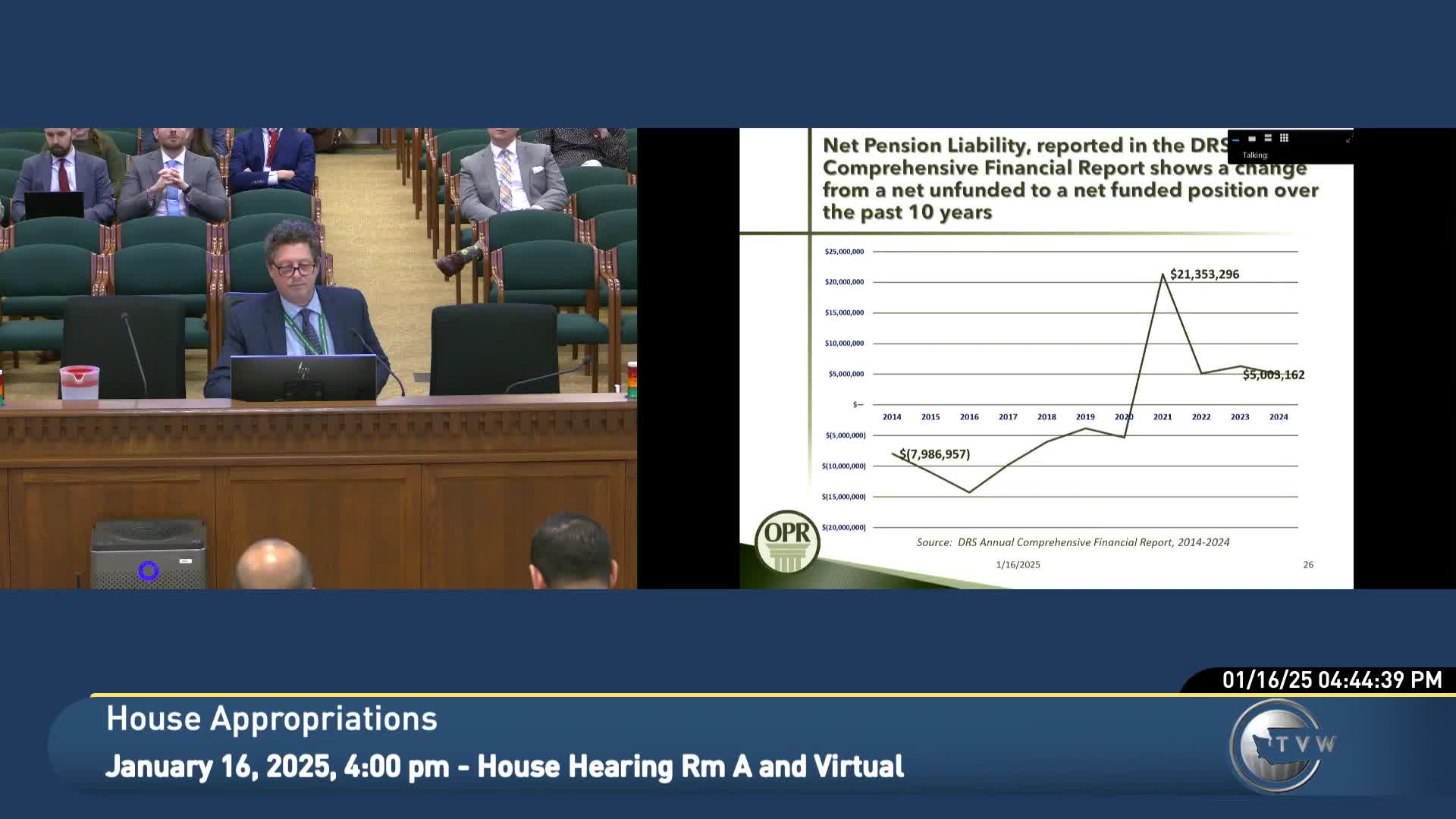State pension plans face $500M unfunded liabilities while LEFT Plan 1 boasts $2.9B surplus
January 16, 2025 | Ways & Means, Senate, Legislative Sessions, Washington
This article was created by AI summarizing key points discussed. AI makes mistakes, so for full details and context, please refer to the video of the full meeting. Please report any errors so we can fix them. Report an error »

In a recent meeting of the Senate Ways & Means Committee, critical discussions unfolded regarding the state’s pension liabilities and their implications for financial stability. The atmosphere was charged with the weight of fiscal responsibility as committee members delved into the complexities of the state’s retirement systems, revealing both challenges and opportunities.
At the heart of the discussion was the state’s pension liability, which is reported as part of its overall debt obligations. The Department of Retirement Systems publishes an annual comprehensive financial report that outlines the financial health of these retirement systems. This report, based on market values, serves as a crucial tool for assessing the state’s creditworthiness. Notably, the state experienced significant investment returns in 2021, transforming its net pension liability from a slight deficit to a substantial surplus.
However, the conversation quickly shifted to the pressing issue of unfunded liabilities within the Public Employees Retirement System (PERS) and Teachers’ Retirement System (TERS) Plan 1. These plans are projected to face unfunded liabilities of approximately $500 million each in the coming years, while the Law Enforcement Officers and Fire Fighters (LEFT) Plan 1 boasts a funding surplus of nearly $2.9 million. The committee explored the reasons behind these unfunded liabilities, which stem from a combination of retroactive benefit increases, underfunding, and low investment returns.
Recent legislative actions have aimed to address these challenges. In 2021, the pension funding council lowered the expected investment rate of return from 7.5% to 7%, which increased the reported liabilities. However, the 2020 Legislature allocated $250 million to the TERS Plan 1 Fund, helping to reduce its unfunded liability. Additionally, the 2023 Legislature implemented new fixed rates for addressing unfunded liabilities, aligning them more closely with the plans' projected needs.
As the committee examined the trajectory of these pension plans, it became clear that while they are collectively on a path toward full funding, significant disparities remain. By the end of the four-year budget outlook, projections indicate a combined surplus of approximately $6.1 billion, with the majority attributed to the LEFT Plan 1.
The discussion also touched on cost of living adjustments (COLAs) for retirees. While the PERS and TERS Plan 1 do not have regular COLAs, the LEFT Plan 1 offers adjustments indexed to inflation. The committee noted that since the repeal of regular COLAs in 2011, there have been five ad hoc increases, with the most recent adjustments providing a maximum increase of $110 per month.
As the meeting concluded, the committee members were left with a clearer understanding of the state’s pension landscape. The discussions underscored the importance of strategic planning and legislative action in ensuring the long-term viability of the state’s retirement systems, a matter that affects not only current employees but also retirees who depend on these benefits for their livelihoods. The path forward remains complex, but the commitment to addressing these financial obligations is evident.
At the heart of the discussion was the state’s pension liability, which is reported as part of its overall debt obligations. The Department of Retirement Systems publishes an annual comprehensive financial report that outlines the financial health of these retirement systems. This report, based on market values, serves as a crucial tool for assessing the state’s creditworthiness. Notably, the state experienced significant investment returns in 2021, transforming its net pension liability from a slight deficit to a substantial surplus.
However, the conversation quickly shifted to the pressing issue of unfunded liabilities within the Public Employees Retirement System (PERS) and Teachers’ Retirement System (TERS) Plan 1. These plans are projected to face unfunded liabilities of approximately $500 million each in the coming years, while the Law Enforcement Officers and Fire Fighters (LEFT) Plan 1 boasts a funding surplus of nearly $2.9 million. The committee explored the reasons behind these unfunded liabilities, which stem from a combination of retroactive benefit increases, underfunding, and low investment returns.
Recent legislative actions have aimed to address these challenges. In 2021, the pension funding council lowered the expected investment rate of return from 7.5% to 7%, which increased the reported liabilities. However, the 2020 Legislature allocated $250 million to the TERS Plan 1 Fund, helping to reduce its unfunded liability. Additionally, the 2023 Legislature implemented new fixed rates for addressing unfunded liabilities, aligning them more closely with the plans' projected needs.
As the committee examined the trajectory of these pension plans, it became clear that while they are collectively on a path toward full funding, significant disparities remain. By the end of the four-year budget outlook, projections indicate a combined surplus of approximately $6.1 billion, with the majority attributed to the LEFT Plan 1.
The discussion also touched on cost of living adjustments (COLAs) for retirees. While the PERS and TERS Plan 1 do not have regular COLAs, the LEFT Plan 1 offers adjustments indexed to inflation. The committee noted that since the repeal of regular COLAs in 2011, there have been five ad hoc increases, with the most recent adjustments providing a maximum increase of $110 per month.
As the meeting concluded, the committee members were left with a clearer understanding of the state’s pension landscape. The discussions underscored the importance of strategic planning and legislative action in ensuring the long-term viability of the state’s retirement systems, a matter that affects not only current employees but also retirees who depend on these benefits for their livelihoods. The path forward remains complex, but the commitment to addressing these financial obligations is evident.
View full meeting
This article is based on a recent meeting—watch the full video and explore the complete transcript for deeper insights into the discussion.
View full meeting
